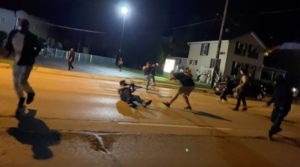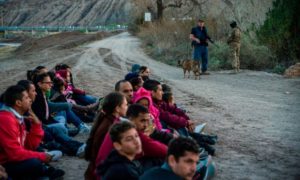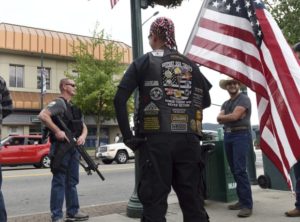News and opinion below
Protests continue in Kenosha, and a “third night of demonstrations [turned] deadly when heavily armed white vigilantes entered” the picture, Huffington Post reported on Wednesday, Aug. 26, 2020. (Read story here.)
A 17-year-old vigilante from Illinois who had recently posted pro-police messages on social media has been arrested and charged with murder after 3 people were shot, 2 fatally. Photographs from the protest scene show a man aiming a rifle at people. (It’s unclear whether the shooter or any victims are in the photo posted below.) Earlier, the sheriff had refused to deputize a group of vigilantes seeking legal authority to patrol the streets. “What happened last night is probably the perfect reason why I wouldn’t,” he told CNN. (Read story here.)
Armed citizens with no police training or arrest authority are more likely to break the law than restore law and order.
 In Kenosha, investigation of last night’s shooting “are focusing on a group of men with guns who were lined up outside some businesses,” the sheriff told news media. “Ostensibly, the vigilantes were there to ‘protect’ businesses from fires that had been set during previous nights of demonstrations,” Huffington Post reported (link above).
In Kenosha, investigation of last night’s shooting “are focusing on a group of men with guns who were lined up outside some businesses,” the sheriff told news media. “Ostensibly, the vigilantes were there to ‘protect’ businesses from fires that had been set during previous nights of demonstrations,” Huffington Post reported (link above).
The 17-year-old was from out of state, and had no legitimate reason for being there. He obviously wasn’t protecting his own property or that of his neighbors. He could only have been there to look for trouble, and he apparently found it. Why would a teen have an assault rifle in the first place? What is he doing at a scene of riots? A person of that age very likely lacks the maturity to handle a tense situation.
Vigilantes, though, usually are older white men — often in their 30s, 40s, and older. Organized rightwing armed militias, effectively small armies (but less trained and disciplined), typically with strong political motivations, have proliferated in recent years. Apart from the militias are many individuals who don’t participate in a group but have a similar mindset. In 2019, a MLB umpire got in hot water for tweeting he was buying an AR-15 and threatening “cival war” if President Trump was impeached (story here). Impeachment is a legitimate process, provided by the Constitution, for removing a president from office; and Trump arguably has committed many impeachable offenses, but GOP senators refused to remove him.
These overwrought and potentially violent groups have been around since before Trump, but his often-violent rhetoric at rallies and in speeches direct against legitimate political opposition and criticism (e.g., “liberals” and “the fake news media”) appears to have encouraged them to come out of the woodwork into the open, and become more threatening.
Although leftwing radicals have been violent in the past, notably during the 1960s antiwar protests, nearly all domestic terrorism of the last few decades has been rightwing, from the Oklahoma City bombing in 1994 to the Bundy Ranch standoff in 2014 (in which organized militias threatened to kill federal law enforcement officers) and the Malheur Wildlife Refuge occupation in 2016 (involving some of the Bundy Ranch anti-government “protesters”).
 In 2019, armed vigilantes patrolling the U.S.-Mexico border illegally detained migrants (story here, photo at left) until the FBI arrested their leader (story here); and “false social media rumors about so-called antifa activists traveling en masse into rural areas of America have led rightwing vigilantes to carry out armed patrols of small cities and towns” (story here; photo at right).
In 2019, armed vigilantes patrolling the U.S.-Mexico border illegally detained migrants (story here, photo at left) until the FBI arrested their leader (story here); and “false social media rumors about so-called antifa activists traveling en masse into rural areas of America have led rightwing vigilantes to carry out armed patrols of small cities and towns” (story here; photo at right).
One of these vigilante “patrols” resulted in criminal harassment of an innocent family, and could easily have led to tragedy, near Forks, Washington, a former logging town now dependent on tourism, in June 2020. There, a mixed-race family of campers traveling in a converted bus were threatened with guns and then trapped in their National Forest campsite by trees felled across the road (story here).
The incident occurred during violent protests in Seattle and Portland following the police killing of George Floyd in Minneapolis. A small group of rightwing locals assumed they were “antifa” based on internet rumors of “antifa” traveling in buses. The family likely also was targeted because one member of the family is black. Rightwing militias and vigilantes are almost exclusively white, and there’s often a strong racist component in their ideology and behind their threatening activities.
While tiny groups of anarchists and leftwing “antifa” (short for “anti-fascist”) troublemakers have shown up at riots and otherwise-peaceful protests following police killings of black people, organized traveling groups of leftists bent on violence and property destruction in small towns have not materialized anywhere. The militias and vigilantes, on the other hand, are a clear and present threat to anyone they’re suspicious of , while their activities haven’t protected much of anything in actual danger. In February 2020, three white men in Georgia, who claimed they were protecting property, confronted and ultimately killed a black jogger, Ahmaud Arbery, who had not committed any crime and was only running for exercise in the street. Those men have been charged with murder and are awaiting trial.
“Antifa” is not an organized group. Wikipedia (here) describes it as a “militant and far-left,” and “highly decentralized movement of political activists,” broadly anti-racist, who “aim to achieve their objectives through the use of both nonviolent and violent direct action rather than through policy reform.” Thus, like rightwing anti-government extremists, they operate outside the law and legitimate political system, and seek to confront “neo-Nazis, white supremacists, and other far-right extremists.” Most are white, but in at least one instance, an organized black militia group confronted a white militia group in Louisville, Kentucky, during a Breonna Taylor protest; that situation remained peaceful (story here).
America has a long history of vigilantism, violent activism, and armed groups (and insurrections, not to mention the Ku Klux Klan) dating back to Revolutionary War days. The constitutional rights of assembly, free speech, and bearing arms virtually guarantee that such groups will continue to exist. They often operate on the borderline between protected rights and criminality. Threatening and menacing aren’t free speech, and any kind of physical assault is a crime.
“Citizen’s arrest,” a form of vigilantism, is a gray area; in some circumstances, it’s legal for private citizens to detain (“arrest”) a person who has committed a crime, but the law is complicated, and citizen’s arrest is fraught with legal (and potential criminal) peril for persons invoking it (see Wikipedia article on the subject here). One thing is clear, though: A person who deliberately goes to the scene of riots or civil unrest looking for trouble probably isn’t going to have any valid legal defenses for whatever he does when he gets there. And a person who detains migrants, “antifa,” or other persons he merely suspects of “doing something illegal” puts himself or herself in serious legal jeopardy.
Today’s riots are a reprise of the 1965 Watts riots, the riots following the 1968 assassination of Rev. Martin Luther King Sr., and other uprisings arising from black grievances against white oppression (which is real and still exists in this country). Thoughtful people will distinguish between peaceful protest, which is a constitutional right, and the violence perpetrated by individuals or small groups. Unfortunately, we have a lot of people in our country who aren’t thoughtful, don’t make these distinctions, and make knee-jerk judgments, aggravated by political ideology and propaganda.
The protests against wanton police violence against blacks are legitimate and warranted. Want to stop the riots? The best way to do that is to stop the police genocide against black people. Meantime, protecting property and bringing rioters to justice is a job for the police, not for vigilantes or armed militias who are ill-trained and psychologically unfit for the job. Yes, it may seem ironic to call on police to deal with riots caused by police behavior. But there are very good cops and rogue cops; and that, too, is a distinction that people on all sides must make before making judgments. The legal system is broken, and doesn’t do enough to protect black people from rogue police, or bring rogue cops to justice. That must change, but it must be changed through legitimate channels. Rioting is a very poor response to that, but past history and present experience strongly suggests rioting is what we’re going to get until it does change. Meanwhile, vigilantes and militias aren’t the solution; they merely add to the problem. They are, themselves, rioters.
All persons accused of crimes are presumed innocent until found guilty in a court of law.